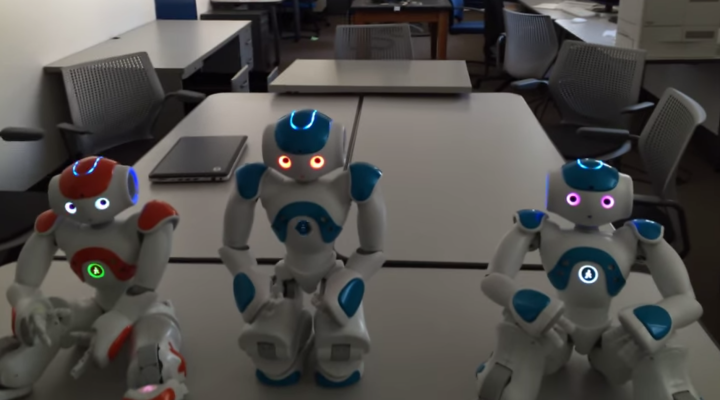
In the experiment, RPI professor professor Selmer Bringsjord subjected three NAO robots (products of French company Aldebaran Robotics) to a version of a classic logic puzzle known as The King’s Wise Men. As the riddle is generally told, three wise men are told that they are wearing hats that are either white or blue, with the guarantee that at least one of the hats is blue. The winner is the wise man who is able to correctly identify the color of his hat, without speaking to either of the other two participants.
But in RPI’s variation of the test, Bringsjord told three robots that two of them had received “dumbing pills,” making it impossible for them to speak, whereas the other had been given a placebo. Researchers then asked the robot whether they’d taken a dumbing pill or the placebo. After a long beat of silence, one robot responds, “I don’t know.” But then, in a delightfully and adorably child-like moment, it raises its hand and says, “Sorry, I know now. I was able to prove that I was not given the dumbing pill.”
This recognition, scientists say, demonstrates a degree of self-awareness in that the robot must have a) understood the rules, b) recognized its own voice, and c) been aware of the fact that it is a separate and distinct individual from the other two participating robots. If nothing else, researchers say, this self-correction was a display of a “mathematically verifiable awareness of the self,” something that has previously remained unproven.
Of course, how self-awareness is ultimately defined has yet to be settled upon, so there’s certainly no need to run screaming for the hills just yet in anticipation of the robot takeover, but it does raise interesting questions about the future of artificial intelligence, and whether we are really that different from our robotic counterparts. The answer could soon change quite drastically.
Editors' Recommendations
- Boston Dynamics uses ChatGPT to create a robot tour guide
- Finishing touch: How scientists are giving robots humanlike tactile senses
- A disembodied robot mouth and 14 other 2020 stories we laughed at
- A.I. fail as robot TV camera follows bald head instead of soccer ball
- Self-driving forklifts are here to revolutionize warehouses, for better or worse


